Adverbs of Place provide information about the location or direction of an action. They answer the question “Where? “in this article, we are providing a complete lesson about the adverb of Place. Learn all about Adverbs of Place and how to use them in sentences. Get examples and tips to help you understand and identify these key phrases.
What Is an Adverb of Place?
An adverb of place is a special word that helps us know where something is happening or which way something is going in a sentence. It answers the question “Where?” It gives more details about the location or direction of an action.
For example, if you say “The cat is here,” the word “here” is an adverb of place because it tells us where the cat is. These words, like “here,” “there,” “everywhere,” or “upstairs,” help us understand more about where things are or which direction they are going. They make sentences more detailed and clear.
Examples of Adverbs of Place
Adverbs of place tell us more about where things happen. These Examples help you understand more about where things are or where they happen.
- The cat is here on the windowsill.
- Put the groceries there on the counter.
- I left my keys somewhere in the living room.
- The scent of flowers is present everywhere in the garden.
- There is peace and quiet nowhere in the bustling city.
- The cat is here.
- Put the keys there on the table.
- I looked for my book everywhere.
- The treasure is nowhere to be found.
- The store is nearby.
- The mountains are far in the distance.
- Let’s go outside and play.
- The warmth of the sun felt great inside the house.
- She went upstairs to her room.
- The kitchen is downstairs.
- The moon is above the horizon.
- The submarine went underwater.
- We live east of the city.
- The beach is west of here.
- The river flows south.
- The compass needle points north.
- The subway is aboveground
- The subway is underground in the city.
- Look for the keys hereabouts.
- The wind blew the leaves everywhere.
- He wandered nowhither.
- The classroom is upstairs.
- The book is somewhere on the shelf.
- The party is happening downstairs.
- Come hither and join us.
- Go thither and explore.
- You can sit anywhere you like.
- I left my keys somewhere in the living room.
- The flowers spread their fragrance everywhere.
- There is peace and quiet nowhere in the bustling city.
- I want to travel everywhere in the world.
- The treasure is hidden nowhere in this room.
- We’re going far to visit the new museum.
- The children are playing outside.
- You can sit anywhere in the auditorium.
- The book you’re looking for is upstairs on the shelf.
- The party is happening downstairs in the basement.
Types of Adverbs of Place
Adverbs of place can be categorized into two main types: simple adverbs and compound adverbs.
- Simple Adverbs of Place:
Simple adverbs of place consist of a single word and directly convey information about the location or direction of an action. Here are some common examples:
- Here: Come here.
- There: Place it there.
- Everywhere: I looked everywhere for my keys.
- Nowhere: He went nowhere.
- Nearby: The park is nearby.
- Far: The mountains are far.
- Compound Adverbs of Place:
Compound adverbs of place are formed by combining two or more words to express a more specific or nuanced location. Here are some examples:
- Anywhere: You can sit anywhere you like.
- Somewhere: I left my keys somewhere in the house.
- Everywhere: The flowers spread their fragrance everywhere.
- Nowhere: There is nowhere to hide.
- Upstairs: She went upstairs to her room.
- Downstairs: The kitchen is downstairs.
Placement of Adverbs of Place
The placement of adverbs of place in a sentence depends on the type of adverb and the verb it is modifying. Here are some general guidelines:
- Simple Adverbs of Place:
- Usually at the end of a sentence:
- She placed the keys on the table there.
- The cat is sleeping on the mat here.
- I’ll meet you at the park nearby.
- Compound Adverbs of Place:
- Generally, after the subject or before the main verb:
- You can sit anywhere in the room.
- The book is somewhere on the shelf.
- The party is happening downstairs.
- With the Verb “To Be” (am, is, are, was, were, etc.):
- After the verb “to be”:
- The classroom is upstairs.
- The treasure was nowhere to be found.
- Beginning or End of a Sentence for Emphasis:
- For emphasis, adverbs of place can be placed at the beginning or end of a sentence:
- Here, take this umbrella with you.
- She lives there, upstairs.
- Mid-Sentence Placement:
- Can be placed in the middle of a sentence for flexibility:
- I saw her standing nearby as I entered the room.
- The children were playing outside, enjoying the sunshine.
- When the Verb Has an Object:
- Generally, after the object of the verb:
- He put the keys here.
- They buried the treasure somewhere in the backyard.
List of Adverbs of Place:
- Here
- There
- Everywhere
- Nowhere
- Nearby
- Far
- Inside
- Outside
- Upstairs
- Downstairs
- Above
- Below
- Near
- Farther
- Away
- Hither
- Thither
- Within
- Beyond
- Backward
- Forward
- East
- West
- South
- North
- Aboveground
- Underground
- Hereabouts
- Everywhither
- Nowhither
Exercises and Worksheet
1: Fill in the Blanks
Fill in the blanks with the appropriate adverb of place:
- The cat is __________ the roof.
- I left my bag __________ in the car.
- Look for your shoes; they might be __________.
- The school is __________ to the library.
- The children are playing __________ in the backyard.
- The keys are __________ the table.
- He traveled __________ to attend the conference.
- The store is __________ to the post office.
- The treasure is __________ in the cave.
- Put the book __________ on the shelf.
Answer:
- on
- somewhere
- anywhere.
- next
- outdoors
- on
- far
- next
- hidden
- up
Exercise 3: Rearrange the Sentences
Rearrange the words in each sentence to place the adverb of place in a different position. Pay attention to how the meaning may change.
- The party is happening downstairs.
- She placed the keys on the table there.
- I saw her standing nearby as I entered the room.
- You can sit anywhere in the room.
- The cat is sleeping on the mat here.
Answer:
- Downstairs, the party is happening.
- There, she placed the keys on the table.
- Nearby, as I entered the room, I saw her standing.
- In the room, you can sit anywhere.
- Here, the cat is sleeping on the mat.
Exercise 4: Combine Sentences
Combine the two sentences into one, using an adverb of place:
- The school is next to the park. The library is in the school.
- The restaurant is across the street. The theater is over there.
- The bus stop is down the road. The grocery store is at the end of the road.
Answer:
- The library is in the school next to the park.
- The theater is over there across the street.
- The grocery store is at the end of the road down the road.
Exercise 5: Identify the Adverb
Read the following sentences and identify the adverb of place:
- They built a treehouse up there.
- The dog is sleeping here.
- I’ll meet you somewhere downtown.
- The keys are hidden nowhere in the house.
- She looked everywhere for her lost necklace.
Answer:
- Up there
- Here
- Somewhere
- Nowhere
- Everywhere
You May Also Like


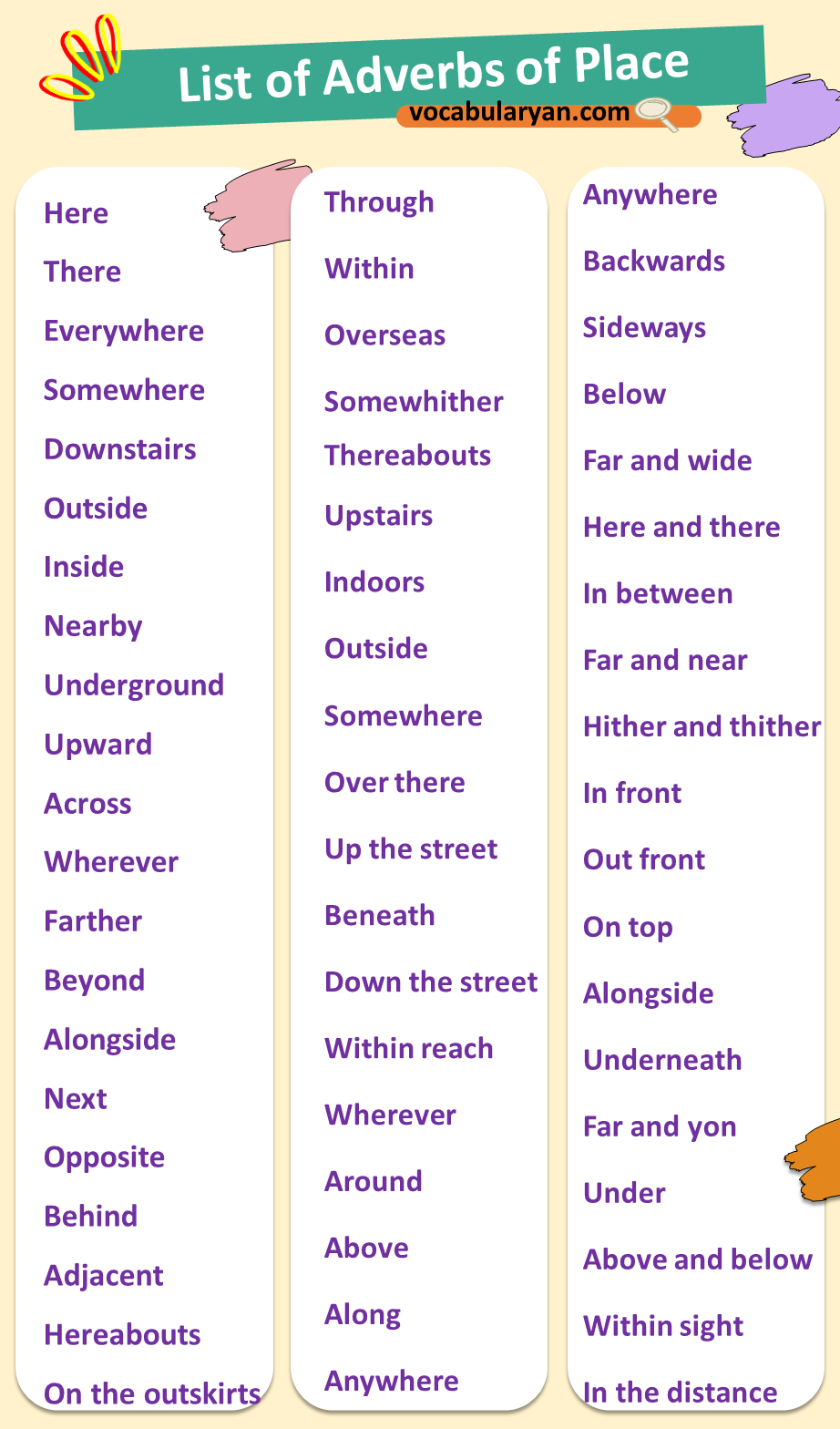
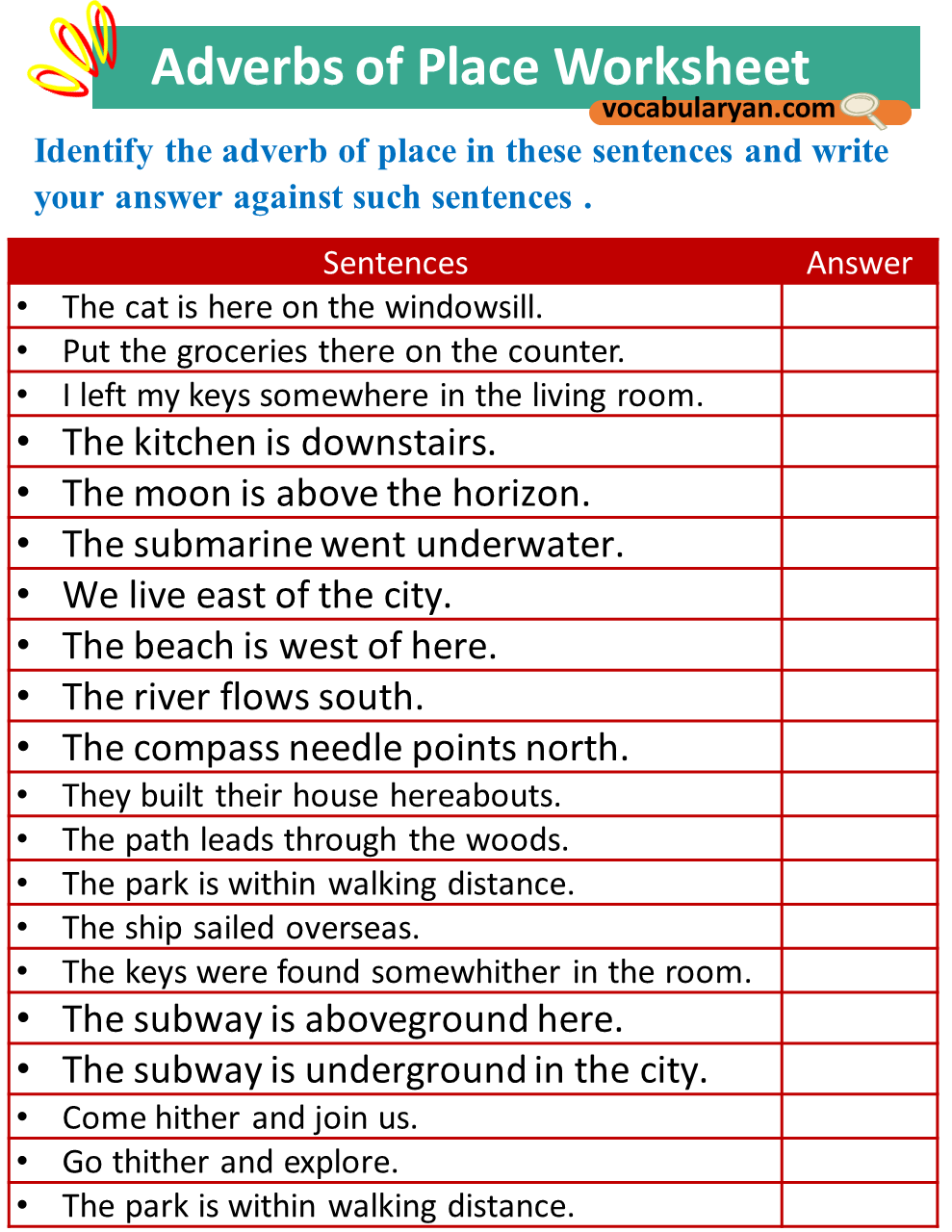
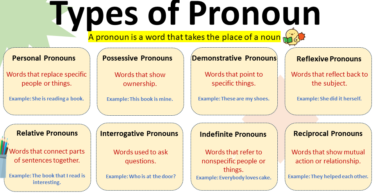
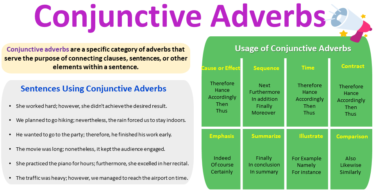
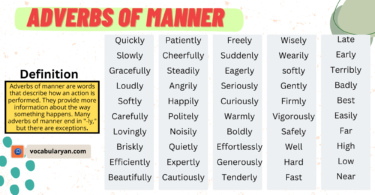
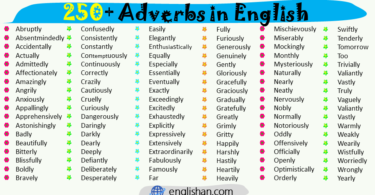
Leave a Comment